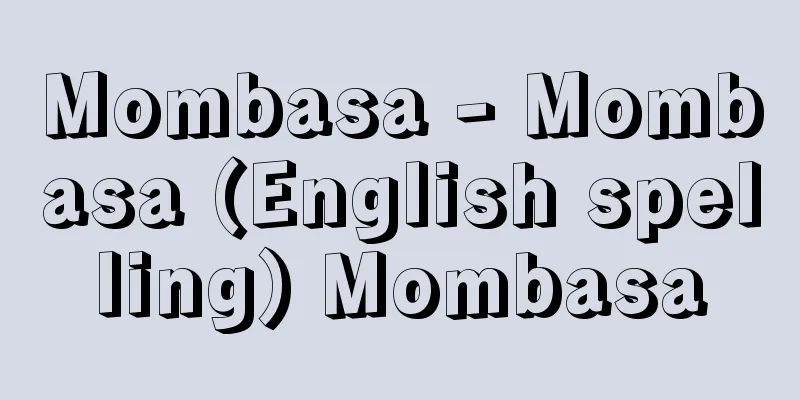Mombasa - Mombasa (English spelling) Mombasa

|
A port city in southeastern Kenya, in central-eastern Africa. With a population of 685,000 (2001 estimate), it is the second largest city in the country after the capital, Nairobi. It straddles the small island of Mombasa (area 13 square kilometers) in the Indian Ocean and the mainland, and is connected by bridges and embankments. It has one of the largest ports in East Africa, and regular ships operate between the city and India, East Asia, Europe, and America. It is also the starting point of a railway line that connects to Uganda via Nairobi, and is also home to an international airport. Its industries include oil refining and chemical manufacturing. Around the 1st century AD, Arabs and Persians engaged in trade between the East African coast and the Arabian Peninsula built a port here, and traveled in dhows (sailing ships) taking advantage of the seasonal winds. Portugal advanced into the area after Vasco da Gama discovered a sea route to India at the end of the 15th century. After many battles between the Arabs and the Portuguese who tried to recapture it in the 17th and 18th centuries, the Portuguese were driven out in the mid-18th century. From the second half of the 19th century, it came under British control, and was the administrative center of British East Africa until 1905. Many Arabs live in the city among Africans, and 40% of the total population is Muslim, with mosques in various places. There are also many Indians, including descendants of workers brought in to build the railway during the early British colonial period, and Hindu temples are scattered throughout the city. The old town, which retains its historical appearance, is located on the eastern side of Mombasa Island. Near the port are the ruins of Fort Jesus, a fortress built by the Portuguese at the end of the 16th century, which is now the National Museum. On the west side of the island is the modern new port of Kilindini, and a new town including an industrial district spreads out around it. The coasts on the north and south of the island are resort areas lined with hotels, and houses extend from the island to the mainland. [Ken Akasaka] Source: Shogakukan Encyclopedia Nipponica About Encyclopedia Nipponica Information | Legend |
|
アフリカ中東部、ケニア南東部の港湾都市。人口68万5000(2001推計)、首都ナイロビに次ぐ同国第二の都市である。インド洋上の小島モンバサ島(面積13平方キロメートル)と本土にまたがり、橋と堤防で結ばれている。東アフリカでも有数の港湾をもち、インド、東アジア、ヨーロッパ、アメリカとを結ぶ定期船が就航する。またナイロビを経由してさらにウガンダに通じる鉄道の起点でもあり、国際空港も所在する。工業は石油精製や化学工業などが行われている。 紀元1世紀ごろ、東アフリカ海岸部とアラビア半島との交易に携わるアラブ人、ペルシア人がここに港を築き、季節風を利用してダウ(帆船)で活動した。15世紀末バスコ・ダ・ガマによるインド航路の発見を契機として、ポルトガルがこの地に進出した。17~18世紀、奪回を試みるアラブ人とポルトガルとの間で、何回も争奪が繰り返されたのち、18世紀中期、ポルトガルは追い払われた。19世紀後半からはイギリスの支配下に入り、1905年までイギリス領東アフリカの行政中心地であった。市内にはアフリカ人に混じってアラブ人が多数居住し、全住民の40%がイスラム教徒で、各所にモスクがある。ほかに、イギリス植民地時代初期、鉄道建設のため導入された労働者の子孫などインド人も多く、ヒンドゥー教寺院も点在する。歴史的たたずまいを残した旧市街は、モンバサ島の東側にある。港の近くには16世紀末ポルトガル人が建設したフォート・ジーザスという砦(とりで)の遺跡があり、国立博物館となっている。島の西側には近代的な新港キリンディニがあり、工業地区などを含む新市街が、これを取り囲むように広がっている。島の南北の海岸はホテルが林立するリゾート地で、本土側には島側から住宅が延びている。 [赤阪 賢] 出典 小学館 日本大百科全書(ニッポニカ)日本大百科全書(ニッポニカ)について 情報 | 凡例 |
<<: Messerschmidia argentea (Lf) Johnston
>>: Monts Dore Mountains - Monts Dore
Recommend
turnout
...This curve is called a vertical curve, and a p...
Crude oil - Genyu
Unrefined petroleum produced from underground. It...
Tatsuno [town] - Tatsuno
A town in Kamiina County, central Nagano Prefectur...
Flag state
Under international law, ships are treated as sepa...
Popular literature - taishu bungaku
A literary term. It generally refers to popular l...
deme
...This kind of unit group has not been noticed b...
Guangxi Zhuang Autonomous Region (English: Guangxi Zhuang Autonomous Region)
A province-level autonomous region in southern Chi...
Aiētēs (English spelling) Aietes
…The main events of the journey are usually said ...
Fortified wine - Kyoukain
…(2) Dessert wines are so named because they are ...
melancholic
...Western words such as temperament, which means...
Todaiji Temple Summary
This is a Todaiji temple journal created during t...
Water-borne infectious disease - Suikeidensenbyo (English spelling) Water-borne infection
Waterborne diseases are those in which excretions ...
Erythrura trichroa (English spelling)
…[Nakamura Toru]. … *Some of the terminology that...
F Machine
… After the Xinhai Revolution, resident officers ...
Kinodomozumodoki - Kinodomozumodoki
...The white-eyed vireo ( V. griseus ) breeds in ...
![RKO Films [Company] - RKO Radio Pictures Inc.](/upload/images/67caddbb923e2.webp)








![Non finito (English spelling) [Italian]](/upload/images/67cc7cbe617c9.webp)